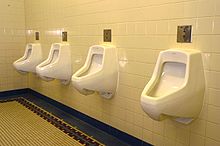Urinal
The mesh is intended to prevent solid objects (such as cigarette butts, feces, chewing gum, or paper) from being flushed and possibly causing a plumbing stoppage.In some restaurants, bars, and clubs, ice may be put in the urinals, serving some of the same purposes as the deodorizing block without dispensing odorous chemicals.[citation needed] Urinals in high-capacity public toilets are usually arranged in one or more rows directly opposite the door, so that users have their backs to people entering or standing outside.They are often installed where there is a high peak demand, such as in schools, music festivals, theatrical events, sports stadiums, discos, dance clubs, and convention halls.They offer the advantages of substantial water savings in residences with many occupants, and reduction of "splash back", making cleaning easier.The Americans with Disabilities Act requires that flush valves be mounted no higher than 44 inches (110 cm) AFF (above the finished floor).In Germany, the United Kingdom, France, the Republic of Ireland, Hong Kong and some parts of Sweden and Finland, manual flush handles are unusual.However, in these countries users are so used to the automatic system, that attempts to install manual flushes to save water are generally unsuccessful.Older timed-flush installations may add a device that regulates the water flow to the cistern according to the overall activity detected in the room.To prevent false-triggering of the automatic flush, most infrared detectors require that a presence be detected for at least five seconds,[citation needed] such as when a person is standing in front of it.This reduces water usage, compared to a sensor that would trigger a continuous flushing action the whole time that a presence is detected.The first waterless urinal was developed at the end of the 19th century by the German-Austrian Wilhelm Beetz using an oil-based syphon with a liquid that he called Urinol.The lighter-than-water sealant floats on top of the urine collected in the U-bend, preventing odors from being released into the air.Waterless urinals may also use an outlet system that traps the odor, preventing the smell often present in toilet blocks.[citation needed] Another method to eliminate odor was introduced by Caroma, which installed a deodorizing block in their waterless urinal that was activated during use.Waterless urinals have become rather common in Germany since about 2009 and can be found at restaurants, cinemas, highway rest stops, train stations and so forth.[9] Due to high-level water restrictions during about 2005-2008 the city council of Brisbane, Australia mandated conversion to waterless urinals.Regular, thorough maintenance of the respective odor control device is needed for all types of waterless urinals, as per the manufacturer's recommendation.Plumbers' unions initially opposed waterless urinals, citing concerns about health and safety, which have been debunked by scientists who have studied the devices.In March 2006, the Associated Press reported that the plumbers' union in Philadelphia had become upset because developer Liberty Property Trust had decided to use waterless urinals in the Comcast Center.In recent years, urinals that can be retracted into the ground during the day or between special events have been installed, in order to save space when they are not expected to be needed.[20] The urinals were re-introduced in Paris after 1834, when over 400 were installed by Claude-Philibert Barthelot, comte de Rambuteau, the Préfet of the Department of the Seine.In response, Rambuteau suggested the name 'vespasiennes',[21] in reference to the 1st century Roman emperor Titus Flavius Vespasianus, who placed a tax on urine collected from public toilets for use in tanning.[22] Unlike Rambuteau's columns, which were entirely open at the front, McFarlane's one-man urinals were designed with spiral cast iron screens that allowed the user to be hidden from sight, and his multi-stall urinals were completely hidden within ornate, modular cast iron panels.A large variety of designs were produced in subsequent decades, housing two to 8 stalls, typically only screening the central portion of the user from public view, with the head and feet still visible.The last design, proposed by a city councillor, was the one adopted in 1878, a cast-iron octagonal structure with seven stalls and a peaked roof, known locally as a Café Achteck ('Octagon Cafe').









Urinal (health care)Urinal (disambiguation)plumbing fixturetoileturinationpublic restroomsWestern countriesMuslim countriesfemale urinalsfemale urination devicemedical analysisstakeoutsbedriddenpublic toiletVienna, Austriapublic toiletsflush toileturinal deodorizer blockcigarette buttschewing gumurinal cakeTokyo, JapanCzech RepublicLos AngelesMunich, GermanyBrisbane, AustraliaStetson Bowl StadiumSurrey, British ColumbiaBostonTamil NaduAmericans with Disabilities Actsiphonpush-buttondoor closerpassive infrared sensorfertilizerSloan Valve CompanyDuravitCaromadeodorizing blockwater conservationBrisbanestruvitecalcium phosphatecorrosivebuilding codesunionsUniform Plumbing CodeAssociated PressPhiladelphiaComcast CenterCalifornia EPACaliforniaArgentinaPissoirmanholeMarikinaBayani FernandoMetropolitan Manila Development AuthorityMetro ManilaLondonVauxhallAmsterdamStockholmGroningenHamburgVaranasiFemale urinalNational Organization for WomenVirgin AtlanticJohn F Kennedy International AirportNew York Cityoral sexurolagniaMcDonald'sInteractive urinalsKorean WarVietnam WarOperation Desert Stormwater bottleAirbusFrench Revolution of 1830Claude-Philibert Barthelot, comte de RambuteauPréfetDepartment of the SeineTitus Flavius VespasianustanningMorris columnUnited KingdomSaracen FoundryGlasgowBaron HaussmannSanisettearchitectural design competitionsCafé Achteckpee curlsJoan van der MeySydneyMelbourneRoman EmperorVespasianSanisettesHonfleurAvenue du MaineCharles MarvillePorto, PortugalheritageBraunschweig, GermanySydney, AustraliaRothesay, ButeMarcel DuchampFountainNassau County, New YorkErnest HemingwaySloppy Joe'sKey West, FloridaJohn GreysonGabriel ChevallierClochemerleurinal cakesMystery of the Urinal DeuceSouth ParkWestern Jin DynastySteampunkBratislavaMadonna Inn